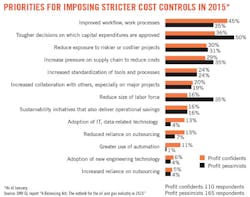As US unconventional operators come under increasing economic pressure given dropping oil prices, executives told a recent DNV GL survey that lessons learned from past downturns need to be remembered during the current rash of budget cuts and other cost-discipline measures.
Elisabeth Torstad, chief executive officer of DNV’s oil and gas business area, said oil and gas leaders face a dilemma. Executives are asking themselves whether to tighten the spending reins and keep an eye on the longer-term outlook or to succumb to shorter-term pressure and slash spending sharply.
"It is bad for the long-term health of the industry to see behavior so tightly bound to oil-price fluctuations," Torstad said in a February report entitled "A balancing act: the outlook for the oil and gas industry in 2015."
Bank of America Merrill Lynch has said most shale projects generate little free cash flow, leaving oil output highly sensitive to price drops on the New York Merchantile Exchange. Merrill Lynch forecast 2015 unconventional oil production growth could be half of what it was in 2014.
Graeme Pirie, DNV oil and gas North America business development manager, expects that unconventional producers will bounce back almost immediately when prices stabilize.
"A lot of the smaller unconventional oil producers will be susceptible in the downturn," Pirie said. "We expect to see an increase in acquisition and lease transfers during this period. The vast supply of unconventional shale oil and gas in the US will remain regardless of the shape of the market and pressure from outside forces."
Industry less confidence
For its report, DNV commissioned Longitude Research to survey more than 360 senior industry professionals and executives. Of the total respondents, 37% were oil and gas companies while 57% were suppliers and service companies.
Only 28% of respondents said they were confident about the industry in January compared with 88% in 2014 and 89% in 2013, the report said. In North America, less than 47% of respondents said they were confident about how their business will perform in 2015, sharply down from 2014.
"This is especially due to the unconventional oil and gas players facing sharp pricing pressures following a general oversupply in the market," the report said. "In a climate of low oil prices, companies will be strongly tempted to slash capital-intensive projects, particularly those that hit their cash flow."
Companies also will scrutinize new investments more closely "to assess whether they are still bankable in a weaker market," the report said.
During an interview associated with the survey, Statoil Chief Economist Erik Waerness said one lesson that companies need to remember is to resist reducing exploration too much too fast. Otherwise, they could find themselves short on reserves in coming years.
Eric Janvier, head of Schlumberger’s Business Consulting capital projects practice, said streamlining processes can reduce risk and help manage risk as can standardizing contracts.
"Instead of starting from the point of view that every field is different and, therefore, you need to design something from scratch," Janvier suggests executives consider "what you as a company have done well in the past, and then, where necessary, designing adjustments in order to optimize."
He advised companies against scrimping on quality, saying, "You get what you pay for."
DNV’s report outlined five key trends:
- Industry’s overall confidence was found to be directly correlated to oil prices. Less than one third of respondents this year forecast they will hit their revenue and profit goals compared with 72% and 69%, respectively, from last year.
- More innovative approaches to cost control are expected. Rising costs and tighter margins drive companies to find creative ways to save money, including adoption of new technologies.
- Investment is on a tighter rein. A far smaller proportion of companies appear willing to increase capital investment in 2015--falling to 12% from a high of 63% in 2012. Meanwhile, 33% said they will keep spending at 2014 levels. But DNV noted "countercyclical investments may offer significant opportunities for the longer term."
- New talent challenges are emerging. Nearly half of respondents expect their company will reduce workforce ranks this year. "Accordingly, the proportion of companies citing skill shortages as a barrier to growth has fallen to less than one-third of the level from last year," DNV said.
- Industry’s profit-confident firms are forging a different path than their peers. The confident companies "show a greater ability to work beyond the oil-price cycle," DNV said.


